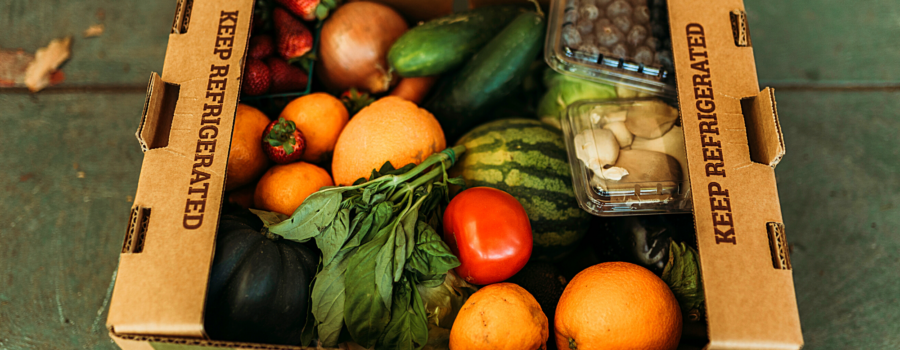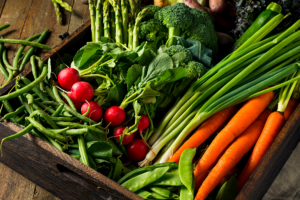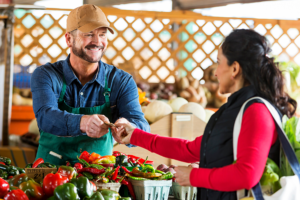For decades, farmers’ markets have been a staple sales outlet for local food producers and an integral part of fresh food access for local communities. When COVID-19 threatened the existence of physical markets, many quickly pivoted to online sales to support their farmers and customers. Over the last year, we here at LFM have supported dozens of farmers markets of all scales as they launched their online sales systems. Using our data and studies done by various departments of the USDA, we have seen an undeniable positive change for farmers markets that have moved online with the LFM platform. In this analysis, we compare the metrics from our farmers market customers between 2019-2020 with studies done on farmers markets nationally to see the impact of e-commerce with farmers markets. Finally, we review six expert tips to make your farmers market successful this year.
Farmers Market Metrics
According to 2015 and 2017 studies by the USDA (U.S. Department of Agriculture, 2016, 2018), there are approximately 8,600 farmers markets in the United States. These markets supported 41,156 farms to produce $711M in annual sales, making up 23% of total direct farm sales of food nationally. This means that on average markets sold $82,675 each per year. For markets utilizing the LFM platform in 2020, the average market sales were $147,637 over just a 30-week period – many of which had never sold online before.
Since many farmers markets went online over the past year, the year over year comparisons for online sales are not as meaningful – but we can compare the data from previous farmers market sales research . In 2020, farmers markets utilizing the LFM platform saw an average order size of $59, with some markets averaging up to $179 per order. Studies show that the average amount spent at a physical farmers market to be $15-$30 per visit, so the average online sale is significantly larger than what the average shopper spends at a physical market (Zepeda and Carroll, 2018). Not only are the individual sales much larger, 56% of LFM’s online farmers market customers ordered on average more than 7 times over a 30-week season (April-Oct) or once every 4 weeks. Looked at another way, more than half of online customers spent nearly $400 per season at their respective markets.
Six Expert Tips to Make Your Farmers Market Successful
-
Consider Your Margins
While the sudden onset of COVID-19 required some quick action without much planning, use this off-season to create (or refine) a sustainable plan. One of the biggest opportunities for improvement we see is in accounting and planning for the increased costs of a successful online market. Many markets are operating their online markets (and oftentimes, also their physical markets) on unsustainable margins, despite offering a huge benefit to their producers and market customers. In order to continue offering this service to stakeholders, markets must take into account their costs of the service and adjust their margins accordingly. After analyzing your costs, communicate those to your producers so they can see the market’s financial picture and how you plan to offer the service more sustainably. Get creative with pickup or delivery fees and suggest tips during checkout (LFM feature coming soon) as a way to improve your margin without significant changes to your margins. If there isn’t appetite for increased margins within your stakeholders, consider a walk through pickup option (vs an aggregated curbside order), which greatly reduces the market’s costs.
-
Streamline Your Packing Process
If you are offering curbside pickup, your single largest cost to offering the service is almost certainly aggregation and packing. Many markets got creative with aggregation – requiring producers to drop items off in customer’s orders or using volunteer labor, while others paid staff to pack orders. Whatever approach you land on, getting an efficient and organized process in place is paramount. Keep items consistently labeled and in designated areas for easy packing. Create order packing stations to limit time loss with staff searching for items or moving orders. LFM provides custom labels, order packing lists, invoices, and more to keep your packing process and distribution organized and streamlined.
As order volume increases, space and facilities can also become an issue. Rather than increasing your fixed costs with warehouse space, consider renting some packing space just for market day. Reach out to other businesses in the area to see if you can partner to share services.
-
Curbside pickup as a complement to, not a substitute, to the physical market
Many markets went online in 2020 because they faced closure due to health department regulations in their area – with some offering only online ordering since. Most markets found that they were not only serving their longtime customers, but they acquired new, loyal customers due to offering curbside pickup. Tamara Cameron, the Market Manager of the Boise Farmers Market, brought their market online with LFM when COVID regulations started. They developed a drive-thru order pick-up system for their market customers, allowing them to continue supporting their local farmer and food community. (You can read more about the Boise Farmer’s Market here.) According to Tamara, “We have found a new customer base that really wants to buy local food but hasn’t or doesn’t want to walk around a farmer’s market to get it. And of course we still have our old standbys, our staunch supporters…but we have found a new group of customers that really prefer it this way.”
“We have to keep the drive-thru (even after we re-open our physical market). These customers want to eat local and they want to buy directly from the farmers. They love purchasing from our farmers market online with LFM.” Markets should consider curbside pickup (or delivery) as a way to to reinforce and enhance their physical market and vice versa.
-
Consider Home Delivery
Across all LFM customers (not just farmers markets), the average home delivery order size ($161) was double that of pickup orders ($79) in 2020. While most markets do not have internal delivery resources, there are many potential delivery partners – including local delivery companies to reach new customers and expand market sales. Consider reaching out to local companies in your area for delivery partnerships, which can bring the added benefit of cross-promotion. A number of markets, successfully offered home delivery for their market in 2020.
-
Use Curbside Sales as a way to bring on additional Producers
Many farmers markets have space constraints and long waiting lists for table space. An online market can allow you to expand your products and producers that don’t fit into the physical market layout. It’s also a great way for regular market vendors to offer pre-order for bulk items or unique products they offer, but don’t have the space to display.
-
Market Your Farmers Market
Even the most successful well-attended markets rely on outreach and regular communication. Customers need to be reminded about the market, and the amazing products they can purchase. For online sales, best practice includes sending at least one weekly email about new products or highlights with embedded shopping links plus a second order reminder about 12-24 hours before ordering closes, sending reminders to confirm abandoned carts (something that can be automated with LFM), and maintaining an active and interesting social media presence. Use social media post boosts and ads to target website visitors or promote new products and events. LFM offers options to include Facebook pixel integration and other marketing automations to increase sales and customer engagement.
As 2021 begins, now is a time when many farmers markets are preparing for the upcoming market season. Due to constant changes with health regulations, e-commerce options for farmers markets have had a very positive impact on market sales and the ability to reach new customers. It’s important to consider an online market and physical markets as complementary, both focused on increasing sales for producers. While it can feel overwhelming operating an online market and physical market during a time with strict COVID regulations, with the right resources and planning, it can be a boon for business. If you’d like to learn more about how LFM can help your farmers market with our robust online sales and distribution platform, reach out or come to an upcoming webinar!
For more information:
- Zepeda, L. and K.A. Carroll. 2018. “Who Shops at a Mature Farmers’ Market?” Choices. Quarter 3. Available online: http://www.choicesmagazine.org/choices-magazine/theme-articles/engaging-consumers-in-the-dynamic-local-foods-marketplace/who-shops-at-a-mature-farmers-market
- S. Department of Agriculture. 2018. Shopping at Farmers’ Markets and Roadside Stands Increases Fruit and Vegetable Demand. Washington, DC: U.S. Department of Agriculture, Economic Research Service. Available online: https://www.ers.usda.gov/amber-waves/2018/march/shopping-at-farmers-markets-and-roadside-stands-increases-fruit-and-vegetable-demand/
- S. Department of Agriculture. 2018. The Relationship Between Patronizing Direct-to-Consumer Outlets and a Household’s Demand for Fruits and Vegetables. Washington, DC: U.S. Department of Agriculture, Economic Research Service. Available online: https://www.ers.usda.gov/webdocs/publications/86878/err242_summary.pdf?v=8062
- S. Department of Agriculture. 2016. Direct Farm Sales of Food. Washington, DC: U.S. Department of Agriculture, National Agricultural Statistics Service. Available online: https://www.nass.usda.gov/Publications/Highlights/2016/LocalFoodsMarketingPractices_Highlights.pdf
Learn more about how LFM can enhance your farmers market.
Get My Demo!




